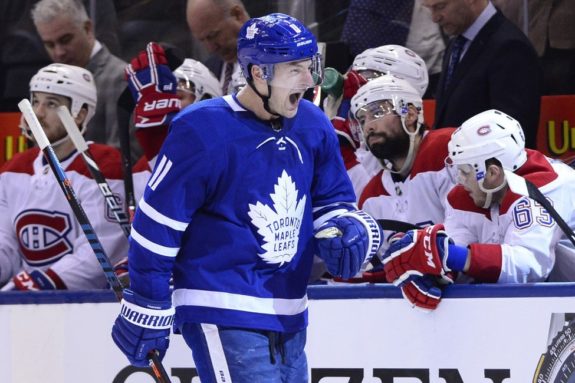The Columbus Blue Jackets face the Toronto Maple Leafs in a best-of-five Qualification Round Series starting Aug. 2 to determine which team advances to the NHL’s 2020 Stanley Cup Playoffs. (The loser of the series has a 1-in-8 chance of getting the top pick in the upcoming Entry Draft.) The Blue Jackets’ top job in the series will be to shut down the high-flying Maple Leafs’ top scorers.

On a points-per-game (PTS/G) basis, five Toronto skaters were far more productive than their teammates: Auston Matthews (1.14 PTS/G), Mitch Marner (1.14 PTS/G), John Tavares (0.95 PTS/G), William Nylander (0.87 PTS/G), and Zach Hyman (0.73 PTS/G). That’s not to undervalue the contributions of Morgan Rielly (0.57 PTS/G, 27 points), Tyson Barrie (0.55 PTS/G, 39 points), Kasperi Kapanen (0.52 PTS/G, 13 goals), or the rest of the team. But there’s a sizable drop off between almost 3/4 of a point per game and a bit over 1/2 P/PG. If the Blue Jackets are to win the series, they need to shut down the big guns.
Maple Leafs’ Scoring vs. Defensive Teams
Together the Maple Leafs’ top five forwards accounted for 141 of Toronto’s 238 regular season goals (60%). But I am a firm believer in the idea that not all goals are created equal. I poured through box scores (most are available through www.hockey-reference.com). I looked for a specific trend: How did these top players produce against the better defensive teams in the regular season? Using the basic metric of goals against, I focused on Toronto’s games against the 10 teams that allowed the fewest goals.

This table lists the Maple Leafs results against those toughest defensive teams. The teams are listed in order of fewest goals allowed.
[table id=346 /]
Seven of the 10 better defensive teams finished above the Maple Leafs in the final league standings, two were tied with Toronto at 81 points (including the Blue Jackets), and one team finished with seven fewer points (the Arizona Coyotes, who lost both games against the Maple Leafs by a combined score of 6-3).
Related: Maple Leafs’ Health & Experience Key to Beating Blue Jackets
Conveniently (from a math point of view) just about 1/3 of the Maple Leafs’ games (24 of 70) were against the 1/3 of the teams with the lowest goals against. Cumulatively, Toronto’s record against those teams was 12 total wins, 10 regulation losses, and an overtime loss and a shootout loss for 26 points.

Toronto’s points percentage for the 24 games was 0.542, compared to a percentage of 0.579 for the season as a whole. (The Maple Leafs’ point percentage in the 46 other games was .598.) These 24 games accounted for 32% of the team’s total points. They scored 75 of their 238 goals (31.5%) in those games.
The numbers are pretty balanced – just about 1/3 of the games against the 1/3 better defensive teams produced almost 1/3 of the team’s total points and included almost 1/3 of the team’s goals scored.

The top-five scorers for the Maple Leafs potted 40 of the 75 goals against the 10 better defensive teams, about 53% of Toronto’s goals in those games. In the other 2/3 of the team’s games, against the other 2/3 of the teams in the league, Matthews, Marner, & Co. scored 101 of Toronto’s 153 goals, over 66% – 2/3 of the team’s goals against those teams.
Toronto’s Reliance On a Few Players
Let’s take a moment to think about that: Toronto’s big five scored over half of the team’s goals against the better defensive teams in the league. But that percent jumps to about 66% against the other 20 teams. While those better defensive teams did limit the effectiveness of Toronto’s key forwards to some degree, the numbers seem to say that there’s only so much you can do against that level of talent.

I went through the box scores of all of Toronto’s games against the 10 best defensive teams in the NHL, and I created tables showing how each of the Maple Leafs’ big five did in each of the 24 games. That, however, was a little overwhelming for an article like this, so instead I’ll present a summary.
[table id=347 /]
That’s a pretty powerful bottom line, with five players accounting for 40 goals and 51 assists in 24 games – games against the teams that gave up the fewest goals during the season. There is one game, however, that skews the stats a bit. The Maple Leafs beat the Hurricanes 8-6 on Dec. 23, 2019. Marner had five points in the game and the big five combined for 14 points:
- Hyman: 0-3-3
- Marner: 2-3-5
- Matthews: 1-1-2
- Nylander: 1-0-1
- Tavares: 1-2-3
Take away that one game and Toronto’s top forwards stat line against the 10 best defensive teams comes a little bit closer to Earth’s orbit: 23 games, 35-42-77. Eliminating that one game drops the players’ combined points-per-game from 3.79 to 3.35, pretty close to 1/2 point per game.

Here’s a look at how these five players did on a game-by-game basis against those 10 stingiest teams.
[table id=348 /]
(If you’re a serious stat head and would like to see tables with the game-by-game breakdown for each of the five players individually, let me know in the Conversation section at the end of this article and I’ll be happy to email them to you. No charge, of course.)
The Much-Maligned Plus/Minus
In these days of advanced analytics (the so-called “fancy stats”), including Corsi, Fenwick, and PDO, the old time plus/minus often gets tossed to the curb. (You can find Toronto and Columbus player advanced stats here.) However, when working with a small sampling of games, advanced stats sometimes get derailed by outlier games, such as the 14-goal monster against the Hurricanes.
Related: Columbus Blue Jackets: The Quest for Success
I find it telling, however, to compare the plus/minus for the players in the 24 games listed above to their plus/minus for the entire 2019-20 season. For “plus” players, multiplying their number for that 1/3 of the season by three should come out pretty close to the full-season plus/minus – if their effectiveness was comparable.
Hyman’s plus-5 in the 24 games compares well to his full-season plus-13. Marner’s plus-2 is completely in line with his full season plus-6. Matthews’ plus-5 in 24 games, when compared to his plus-19 for the season, shows that perhaps he was held a bit more in check by the 10 best defensive teams.

Nylander and Tavares, on the other hand, were “minus” players, both in the 24 games and for the season as a whole. Despite scoring 18 points in the 24 games, Nylander was a whopping minus-10. His full season stat was minus-2. Tavares scored 16 points in the 24 games, but ended up minus-5 (minus-7 for the full season).
For the full season, Matthews’ plus-19 led the Maple Leafs, with Hyman’s plus-13 third. Of the 23 skaters who played in at least 1/3 of the team’s regular season games, Marner’s plus-6 ranked #8, Nylander’s minus-2 ranked #17, and Tavares’ minus-7 was 22nd.
Matching Up Against Toronto’s Two “Top Lines”?
So, what do you do when you have basically two top lines against which you need to match up? Do you go strength against strength, sending out your top line, or hope for a checking line against one of the top sets of forwards? Don’t forget the home ice advantage. From the NHL rulebook:
“82.1 Line Change – Following the stoppage of play, the visiting team shall promptly place a line-up on the ice ready for play and no substitution shall be made from that time until play has been resumed. The home team may then make any desired substitution, except in cases following an icing, which does not result in the delay of the game.”
NHL 2019-2020 Official Rules
My colleague Mark Scheig projects the Blue Jackets’ starting lines here. A third line of Nick Foligno-Boone Jenner-Emil Bemstrom is certainly a possibility. (They finished the regular season with a combined 75 points, but all were on the wrong side of the plus/minus stat.) Or do you look for a defensive pair matching up against a specific forward line? (The Blue Jackets’ top defensive duo Seth Jones and Zach Werenski averaged about 25 and 24 minutes per game of ice time, but that still leaves over half of each game for the 2nd and 3rd pairings.)
For the 1st two games of the best-of-five Qualifying Round, Maple Leafs coach Sheldon Keefe will have home-ice advantage. We don’t know what Blue Jackets coach John Tortorella has up his sleeve to counter the Maple Leaf’s top-five forwards. (If you plan on looking inside his head, take a flashlight – it’s probably dark and twisty in there. But in a good way.)

Assuming/hoping that a COVID-19 outbreak doesn’t interrupt the Qualifying Round series, it will be the Maple Leafs “Fantastic Five Forwards” against the Blue Jackets’ forecheck, defensive depth, and stellar goaltending. Whichever team imposes its style of play will move on to the Stanley Cup Playoffs.